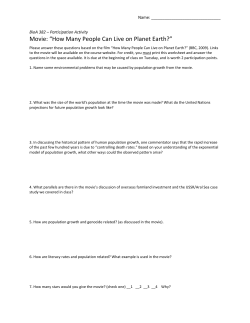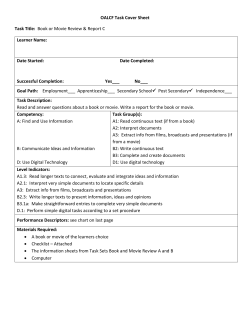
WHY DO I BEHAVE THE WAY I DO? By John Louis
WHY DO I BEHAVE THE WAY I DO? By John Louis Copyright © Louis Counselling & Training Services Pte Ltd, 2010 “In a world of too much information, Good Enough Parenting uses movies to teach parents how to MEET CORE NEEDS, and, at the same time, how to avoid passing down their own dysfunctional behaviors. Schema Therapy has been successful with adults, but I have always wanted to see someone do something on preventing schemas, or Lifetraps, in children, and here it is!” ! ~ Dr Jeffrey Young! Dept of Psychiatry, Columbia University, USA! Founder, Schema Therapy! DYSFUNCTION …is the gift that keeps on giving… Proverbs 17: 22 22 A cheerful heart is good medicine, but a crushed spirit dries up the bones. Proverbs 18: 14 14 A man's spirit sustains him in sickness, but a crushed spirit who can bear? DYSFUNCTION Meeting emotional needs is not as easy and intuitive as meeting physical needs. For many, it is actually counter-intuitive… DYSFUNCTION Children are put in harms way unintentionally as a result of parents’: a. Ignorance b. Lack of training This stuff only makes sense when we are taught. (Most mistakes from our parents were unintentional!!) Many of us don’t know how to explain when our emotional needs are not being met… Why do we behave the way we do? Growing older, having relationships makes us look deeper into ourselves to ask, “Why do I behave the way I do?” Many factors effect our behavior: Temperament is our inborn emotional makeup, as in the way we are built to respond to events. Environment Birth order? Birthplace? Neighborhood? Type of school? Also one important factor based on our family environment… Core Needs Core Needs » Needs required in order to not hurt others or self. » Should not give too much or too little. Important to strike a balance. Core Needs 1. Basic Safety 2. Guidance & Protection 3. Stable Base & Predictability 4. Reasonable Limits 5. Love, Nurturing & Attention 6. Empathy/Validation of Feelings 7. Acceptance & Praise 8. Faith (Spirituality) Why do we behave the way we do? » Temperament » Environment » Parenting » Core Needs Met When core needs are not met… (combined with temperament and environment)... Children get discouraged and they develop lifetraps Colossians 3: 21 21Fathers, do not embitter your children, or they will become discouraged. (NIV) Fathers, do not aggravate your children, or they will become discouraged. (NLT) 21 21Parents, don't come down too hard on your children or you'll crush their spirits. (The Message) Lifetraps …and during that process of unmet needs, we develop Lifetraps (Schemas) » Lifetraps are deeply entrenched beliefs about ourselves and the world which we learn early in life. » Lifetraps are broad themes made up of memories, emotions and cognitions As we get new information, we correct our views… e.g. The boundaries of an old map are altered and corrected to form a new map Old map was… » » out of shape… out of scale… Hence, distorted view… Lifetraps Many of us have painful memories. A few of us have pleasant and many also have a mixture of both. Sometimes we get triggered thinking about them and we feel like throwing stones at them… Movie Therapy » Play movie scene(s) There are 18 such lifetraps. Dr. Jeffrey Young found this after 20 years of research (See handout) 2 Corinthians 10:5-6 5We demolish arguments and every pretension that sets itself up against the knowledge of God, and we take captive every thought to make it obedient to Christ. 6And we will be ready to punish every act of disobedience, once your obedience is complete. 18 Different Lifetraps Session 1 DISCONNECTION & REJECTION 1. Abandonment / Instability 2. Mistrust / Abuse 3. Emotional Deprivation (nurturance, empathy, protection) 4. Defectiveness / Shame 5. Social Isolation / Alienation 18 Different Lifetraps Session 2 IMPAIRED AUTONOMY & PERFORMANCE 6. Dependence / Incompetence 7. Vulnerability to Harm or Illness 8. Enmeshment / Undeveloped Self 9. Failure 18 Different Lifetraps OTHER-DIRECTEDNESS 10. Subjugation 11. Self-Sacrifice 12. Approval-seeking / Recognitionseeking 18 Different Lifetraps Session 3 IMPAIRED LIMITS 13. Entitlement / Grandiosity 14. Insufficient Self-Control / SelfDiscipline 18 Different Lifetraps Session 4 OVERVIGILANCE & INHIBITION 15. Negativity / Pessimism 16. Emotional Inhibition 17. Unrelenting Standards / Hypercriticalness 18. Punitiveness The Three Coping Styles There are three ways we cope when our lifetraps are triggered. We become: a. Surrendered (Fright) b. Avoidant (Flight) c. Counterattacking (Fight) Young, J. E., & Klosko, J. S. (1994). Reinventing your life. New York: Plume , 35. Surrendered The message of this coping style is, “What my lifetrap is telling me about myself is true. I am powerless to change this painful truth about myself.” Avoidant The message of this coping style is, “It is too painful and uncomfortable to hear/feel the message of my lifetrap. I must keep myself separate and distracted so I am not aware of this painful truth about myself.” Counterattacking The message of this coping style is, “I must fight as hard as I can to think and act as though what my lifetrap says about me is not true.” Most people have a predominant coping style Which one is yours? Romans 7: 14-25 14We know that the law is spiritual; but I am unspiritual, sold as a slave to sin. 15I do not understand what I do. For what I want to do I do not do, but what I hate I do. 16And if I do what I do not want to do, I agree that the law is good. 17As it is, it is no longer I myself who do it, but it is sin living in me. 18I know that nothing good lives in me, that is, in my sinful nature. For I have the desire to do what is good, but I cannot carry it out. Romans 7: 14-25 19For what I do is not the good I want to do; no, the evil I do not want to do—this I keep on doing. 20Now if I do what I do not want to do, it is no longer I who do it, but it is sin living in me that does it. Romans 7: 14-25 21So I find this law at work: When I want to do good, evil is right there with me. 22For in my inner being I delight in God's law; 23but I see another law at work in the members of my body, waging war against the law of my mind and making me a prisoner of the law of sin at work within my members. 24What a wretched man I am! Who will rescue me from this body of death? Romans 7: 14-25 25Thanks be to God—through Jesus Christ our Lord! So then, I myself in my mind am a slave to God's law, but in the sinful nature a slave to the law of sin. DISCONNECTION & REJECTION 1. Abandonment / Instability 2. Mistrust / Abuse 3. Emotional Deprivation (nurturance, empathy, protection) 4. Defectiveness / Shame 5. Social Isolation / Alienation 1. Abandonment The core message of the abandonment lifetrap is, “I cannot count on anyone for consistent support, caring, and connection. I will be rejected; people I love and need will die; and people I love and need cannot be relied upon to be there when I need them.” Movie Therapy » Play movie scene(s) Processing Abandonment » Possible Origins – Unstable parent, not physically there, death, divorce… » Exaggerated view that others will leave… » Difficult when handling separation from a mentor/small group. Overly compliant to avoid separation. » Tests relationships to see if people will leave. » Makes leader their central stable figure. Goal of Treatment… » Be more realistic about the stability of current relationships, not believing in their exaggerated views. 2. Mistrust / Abuse The core message of the mistrust/abuse lifetrap is, “I cannot expect others to treat me in a fair, considerate or just manner. I should expect to be hurt (emotionally or even physically), lied to, manipulated, and taken advantage of. Others always have their own agenda.” Movie Therapy » Play movie scene(s) Movie Therapy » Play movie scene(s) “Sticks and stones may break my bones but words will not hurt me…” …words like “useless”, “ idiots” “good for nothing”… Movie Therapy » Play movie scene(s) Movie Therapy » Play movie scene(s) Processing Mistrust & Abuse » Choose abusive partners…and allow to be abused. » Some are “savior” of others and express outrage against perceived “abusers”. » Twist people’s behavior constantly. » Teach them to vent appropriate anger on those who abused them during childhood, not on others. » Face dark truths and enter into their world courageously. » Don’t work if they are not ready. » Takes a long time to treat… Goal of Treatment… » People are not either, ”black or white”, rather than being on a spectrum of trustworthiness. 3. Emotional Deprivation The core message of the emotional deprivation lifetrap is, “I cannot expect others to be supportive of me and care about what I need.” Emotional deprivation is about insufficient empathy, nurturing, and/or not receiving guidance and direction. Movie Therapy » Play movie scene(s) Movie Therapy » Play movie scene(s) Processing Emotional Deprivation » Most common, but many not aware of this » Often feel lonely, bitter, depressed and not knowing why… » Sometimes, like defectiveness associated with Narcissism. Strong feelings of entitlement. » Children spoilt materially, not given genuine love. » Very needy…can expect loved ones to “read their mind…” Goal of Treatment… » Be aware of their emotional needs, not see it as being weak to ask… » Express them appropriately, not mind reading… » They see people as “black” or “white”, rather than on a spectrum. Movie Therapy » Play movie scene(s) 4. Defectiveness The core message of the defectiveness lifetrap is, “I am not good enough. I am inherently flawed. Anyone who truly knows me could not love me.” Movie Therapy » Play movie scene(s) Processing Defectiveness » Most people are not aware of this. Allow others to devalue them. » Hold back information from sharing – shame. They feel defective about who they are, not what they do… » The earlier and more severe the criticism, the most difficult it is to change. » Make a lot of comparisons… » Low sense of self-esteem » Associated with Narcissism; Strong feelings of entitlement. » Difficult to accept compliments » Difficult to accept feedback Goal of Treatment… » To accept their flaws and imperfection…it is part of being a human. Increase their self-esteem. 5. Social Isolation The core message of the social isolation/ alienation lifetrap is, “I am different from other people and do not fit in.” The feelings of isolation and being alone stem from feeling apart from any group or community, and too different to belong. Movie Therapy » Play movie scene(s) Processing Social Isolation » Avoidance of social situations; on the periphery…Very lonely. » Pretend to fit in » Slowly fit into group. Goal of Treatment » Feel less different than others. » Related to defectiveness. In Conclusion…this domain contains the most common lifetraps. We should take extra care to understand this group of schemas. Thank you for your participation today! “Why do I behave the way I do?” is… brought to you jointly by Louis Counselling & Training Services Movies licensed by Motion Picture Licensing Corporation
© Copyright 2025












